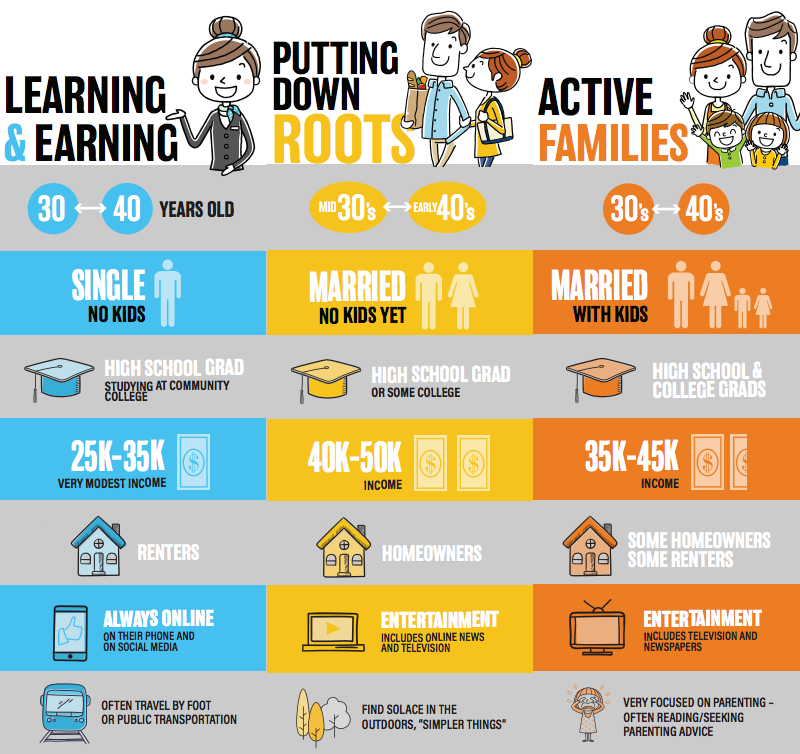MILLENNIAL IS NOT A 4-LETTER WORD
The other day, a friend of mine was complaining that one of her clients still thought of her as a millennial. It wasn’t the label that bothered her, it was the stereotype. The client was attributing all the perceived negative attributes of the millennial generation to her – all because of her age. Sure she’s 24, single and walks into most meetings with a $5 latte, but diminishing her by sticking on a label cast aside who she really is: intelligent (more than most), hard-working, and successful with a decent amount of disposable income.
You’re probably reading this and thinking the same thing – what an injustice. Labeling people, stereotyping people, being dismissive – how crude. You’re right, but it’s how many companies and marketers execute their strategy, build their ads and write copy to speak to customers – stereotypes. I can’t count the times I hear “I need to reach millennials (or Gen-Xers or Boomers).” Of course, you do, but you need to go beyond broad stereotypes to be successful.
Lifestage segmentation is the method good marketers use to dive deeper. Instead of comparing basic demographics we look at behaviors, cultural influences and lifestyles to find smaller sub-sections of a market. Sound complicated? It’s not, it’s just the way life is. Take the real world example of my friend, the “millennial.” She’s 24, but she’s also a mom with a toddler. She’s successful – advancing quickly and earning more than 90% of her millennial peers. She has a mortgage, day care payments, a healthy retirement fund and an avid gardener. Now, let’s compare her to my other colleague, 25. He’s a recent college grad – took him a while to get through. Barista, single, rents housing, has two roommates, and thinks gardening is something his grandparents do to pass the time – in retirement.
Lifestage segmentation is the method good marketers use to dive deeper. Instead of comparing basic demographics we look at behaviors, cultural influences and lifestyles to find smaller sub-sections of a market.
Lifestage segments don’t always fit into the generational buckets we’ve created. The 24-year-old mom shops and spends like my 40-year old neighbor with a 4-year-old. So, if that’s your target, you need to target accordingly – and only focusing on age just won’t cut it. Segmentation works no matter who you’re trying to reach.
See how it works with some that span from Gen-X to Boomers.
Here are some examples of younger adult segments.
Want to take your marketing to the next level? Talk to the folks doing your marketing. Challenge them to take a closer look at your marketing – or most importantly, at the way they are dividing up and targeting your marketing to your prospect and customers.
Your marketing partners need to operate at this deeper strategic level. It’s not hard to understand, but it’s not easy to do well. A good partner can help you understand your market and identify the segments you should be going after. If you have large customer databases – names, addresses, emails – then you can go even deeper by gaining spending, behavioral and demographic data. With this info you’ll quickly see who you’re doing a good job attracting and who you’re missing.
Segmentation isn’t the magic bullet, it’s the foundation for successful marketing. You must know who your customers are before you can think about how to reach them and what to say to get them in the door.
Contact us to learn about how we can help you reach the right audience for your destination.
Learn more about how we can help you adapt to the evolving marketing landscape and ramp up your efforts.
Share This Story, Choose Your Platform!
March 24, 2025

Creating Your Visual Voice
In a recent episode of Field Notes, host Eric Hultgren sat down with Terrance Weinzierl, Executive Creative Director at Monotype, to discuss the often overlooked yet crucial role typography plays in brand identity. While their conversation covered broad typography trends, several insights emerged that are particularly valuable for travel marketers looking to differentiate their destinations in an increasingly crowded digital landscape. [...]
March 11, 2025

The 2025 Sprout Social Index
Social media isn't just another channel for travel marketers—it’s the center of modern culture, a place where travelers discover their next adventure, make purchasing decisions, and even seek customer support. The 2025 Sprout Social Index™ reveals valuable insights about what consumers really want from brands on social media, offering travel marketers a clear roadmap for staying relevant and impactful. Social is the [...]
February 24, 2025

Standing Out in a Crowded Space
In a recent episode of Field Notes, host Eric sat down with Kyle Stichtenoth, Senior Director of Digital Sales and Strategy at Advanced Travel and Tourism, to explore the evolving landscape of travel marketing. With 15 years of industry experience, Stichtenoth offered valuable insights into how destinations can adapt to changing traveler behaviors and emerging technologies. The conversation kicked off with [...]




 Ad Choices
Ad Choices